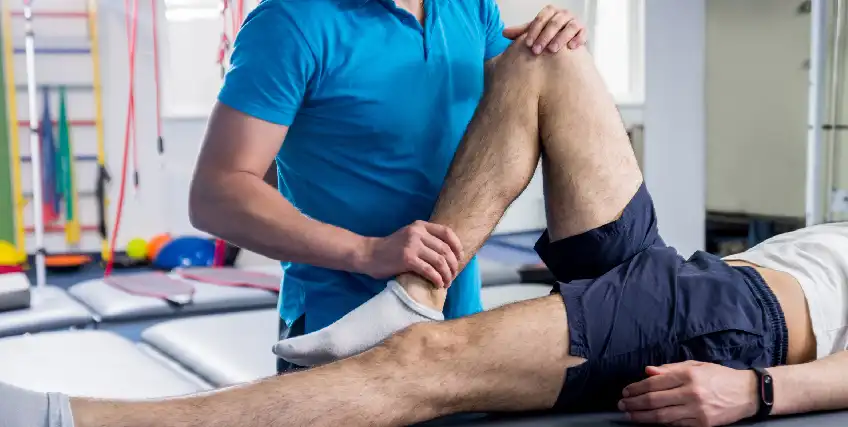How Physical Therapy Clinics Can Use Loans to Grow and Scale
August 05, 2025 | Last Updated on: August 06, 2025

In today’s time, physical therapy clinics do more than just providing expert treatment. They also operate as modern healthcare facilities with increasing operational demands. Many physical therapy clinic owners across the U.S. now face the challenge of meeting patient demand while navigating rising costs of growth.
Expanding your physical therapy practice can help you serve more patients and stay competitive in the local market. To fund it without emptying your savings loans for physical therapy practice can be helpful.
This guide walks you through smart financing options for physical therapy clinics, how to use them, and some common costs involved. We’ll also explore the benefits of using business loans for physical therapy practice.
Why Physical Therapy Clinics Are Scaling Up
The demand for physical therapy in the U.S. continues to rise as more people have started to prioritize recovery, mobility, and long-term health maintenance. Clinics that strategically expand now can address increasing patient needs and improve access to care in their communities.
Many small business owners in this space are broadening their services to include facilities like home visits, aquatic therapy, and specialized treatments. However, these additions require more clinical space, licenses, staff, advanced healthcare equipment, and updated technology systems.
A limited operation may reduce your capacity to meet demand or compete with larger providers. Therefore, a growth-focused physical therapy clinic can increase reach, provide faster service, and improve the overall patient care experience.
Common Costs Involved in Growth
Growing a physical therapy business comes with a lot of financial responsibilities. Knowing these costs can help you plan your funding.
- Commercial real estate: Leasing a larger space or buying your own clinic location.
- Renovations: Making the treatment space accessible and professional.
- Equipment financing: Purchasing rehab tools, ultrasound units, and therapy tables.
- Hiring staff: Onboarding licensed physical therapists and administrative professionals.
- Marketing: Running digital ads, credit card promotions, and patient outreach.
- Software: Upgrading billing systems, scheduling, and EMRs.
- Opening a second location: Expanding your physical therapy business to new regions.
Popular Loans for Physical Therapy Practice
Selecting the right type of loan for physical therapy practice can help your business grow efficiently. However, each loan option comes with different repayment terms, interest rates, and usage.
Here are some of the popular loans for physical therapy practice.
SBA Loans
SBA loans are one of the popular financing options backed by the U.S. Small Business Administration. These therapy business loans are designed to support small business owners. They often come with lower interest rates and longer repayment terms.
Physical therapy clinics can use SBA loans to purchase commercial real estate, invest in new medical equipment, renovate treatment areas, or hire additional physical therapists. Since these business loans for physical therapy are partially guaranteed by the SBA, lenders are more willing to extend capital to businesses with solid financials and growth potential.
Term Loans
Term loans are a standard financing solution where borrowers receive a lump sum loan amount upfront. These loans for physical therapy practice typically feature fixed interest rates with a structured repayment term.
Healthcare professionals can use term loans to fund large one-time projects like clinic expansions, facility upgrades, or investments in new services. Additionally, clinic owners can use these business loans for physical fitness centers to manage purchases like remodeling treatment areas or adding more therapy rooms.
Equipment Financing
Equipment financing is a funding solution designed for businesses to acquire essentials tools and machinery without paying large upfront money. Here, the funds can be paid in monthly payments. Also, the equipment serves as collateral, reducing the risk to the lender.
Equipment loans for physical therapy practice can be used for purchasing rehab equipment, therapy tables, or mobility aids. As a result, these can be used to improve treatment quality and keep pace with evolving patient needs without using your cash reserves.
Business Line of Credit
A business line of credit is a flexible financing option that offers revolving credit that businesses can tap into when needed. Here the necessary funds can be drawn up to a set credit limit, where interest is charged only on the amount used.
Physical therapy providers can use a line of credit to cover short-term expenses such as payroll, inventory, or temporary cash flow issues. These loans for physical therapy practice are useful for handling seasonal dips, working capital, or funding marketing campaigns to attract new patients.
Commercial Real Estate Loans
Commercial real estate loans are long-term financing options used to purchase or renovate business properties. These loans for physical therapy practice are often available through banks, credit unions, funding providers or SBA-backed programs.
Clinic owners can use commercial real estate loans to acquire larger facilities, build new treatment centers, or renovate existing locations to serve patients. However, to qualify for these business loans, lenders usually look for strong tax returns, good credit scores, and reliable revenue.
Microloans
Microloans are small business loans, typically under $50,000. These loans are offered by nonprofit lenders or community development institutions. They are ideal for startups or businesses that are just getting started or need a modest financing boost.
In physical therapy clinics, microloans are commonly used for hiring a new staff member, purchasing basic software, or covering initial marketing expenses. These loans are often easier to qualify for and come with supportive resources for new business owners. They offer manageable loan amounts and are often backed by nonprofit lenders.
Benefits of Financing Growth for Physical Therapy Clinics
Securing the right loan for physical therapy practice offers multiple advantages that can fuel the growth and stability of your physical therapy clinic. With the healthcare industry evolving quickly, clinic owners must be ready to scale without compromising service quality or patient satisfaction.
Here are some important ways that loans for physical therapy practice can drive success:
- Improve patient care: Offer more services with better tools and therapists.
- Manage working capital: Spread costs through regular loan payments.
- Support business needs: From staffing to marketing and everything in between.
- Refinance old debt: Replace high-interest loans for physical therapy practice with better repayment terms.
- Access specific loans: Match funding to your practice’s exact needs.
- Scale operations: Reach more patients without burning your cash reserves.
- Explore loan forgiveness options: Some healthcare-related SBA programs offer partial forgiveness based on use and repayment history.
What Lenders Look for in Physical Therapy Businesses
When you apply for loans for physical therapy practice, lenders review several factors to assess your eligibility:
- Credit score: Both personal and business credit are reviewed.
- Cash flow: Reliable income assures lenders of loan repayment ability.
- Business plan: Includes patient growth, revenue forecasts, and expenses.
- Tax returns: Shows income, stability, and financial discipline.
- Industry experience: How long you’ve operated your physical therapy practice.
- Loan repayment history: Positive past performance helps gain lender confidence.
Tips to Prepare for Loan Application
Understanding the loan application process helps avoid delays and rejections when applying for loans for physical therapy practice.
- Gather documents: Recent tax returns, income statements, and proof of business ownership.
- Outline your goals: Know why you need the loan amount and how it’ll be used.
- Explore all financing options: SBA loans, term loans, or working capital loans.
- Strengthen your credit: Pay off credit card balances and fix credit report errors.
- Build a strong plan: The American Physical Therapy Association offers templates and advice for business owners.
- Be specific: Match your loan request to your business needs and growth plans.
Conclusion
Your physical therapy practice plays an important role in promoting health, mobility, and recovery within your community. It represents more than just a business, it’s a trusted healthcare destination.
Expanding your clinic can open the door to new opportunities like more treatment rooms, specialized therapy services, or even multiple locations. It allows you to meet the rising demand for quality care while maintaining efficiency and patient satisfaction.
Access to loans for physical therapy practice can make these growth plans achievable without straining your clinic's cash flow. These business loans offer the financial flexibility to invest in what matters most: your patients, your staff, and your future.
Now may be the right time to explore loans for physical therapy practice. Your goals deserve strong financial backing.
FAQs About Loans for Physical Therapy Practice
What types of loans are most commonly used by physical therapy clinics?
Physical therapy clinics often explore several types of financing options, depending on their business stage and goals. Some may choose SBA loans for their low interest rates and longer repayment terms, especially if they’re planning a large expansion. Others may prefer equipment financing if they need to upgrade therapy machines or buy new technology. Lines of credit or working capital loans can also be practical for managing day-to-day cash flow. Hence, the best choice often depends on what the clinic wants to achieve and how quickly it needs access to funds.
How can a physical therapy clinic qualify for a small business loan?
Lenders typically look at various factors when evaluating a clinic’s eligibility. This can include the business’s credit score, revenue history, and financial documents like tax returns or cash flow statements. They may also consider how long the clinic has been operating and if the owner has prior experience in healthcare. Additionally, a strong business plan with clear growth projections and a strategy for loan repayment can also influence approval.
How can financing support the growth of a physical therapy clinic?
Loans for physical therapy practice can open doors for growth by helping clinic owners afford investments that would otherwise take years to fund out of pocket. This could include expanding into new locations, purchasing modern rehab equipment, or hiring additional physical therapists. Some may even use loans for marketing strategies, improving patient experience, or switching to better point-of-sale systems.
Are SBA loans a good fit for physical therapy clinics?
Many clinic owners consider SBA loans for physical therapy practice because they are known for their competitive interest rates and longer repayment terms. These loans are partially backed by the U.S. Small Business Administration, which makes them less risky for lenders. However, SBA loans typically have a more detailed application process and may take longer to secure.
What should a clinic owner prepare before applying for a loan?
Preparation often starts with collecting key documents, such as business financials, recent tax returns, and proof of ownership. It can also help to clarify how the loan will be used and build financial projections that outline expected growth. Some lenders may ask for personal credit history or details about the clinic’s staffing and services. Moreover, putting together a complete business plan can also show lenders that you’ve thought through your goals.



